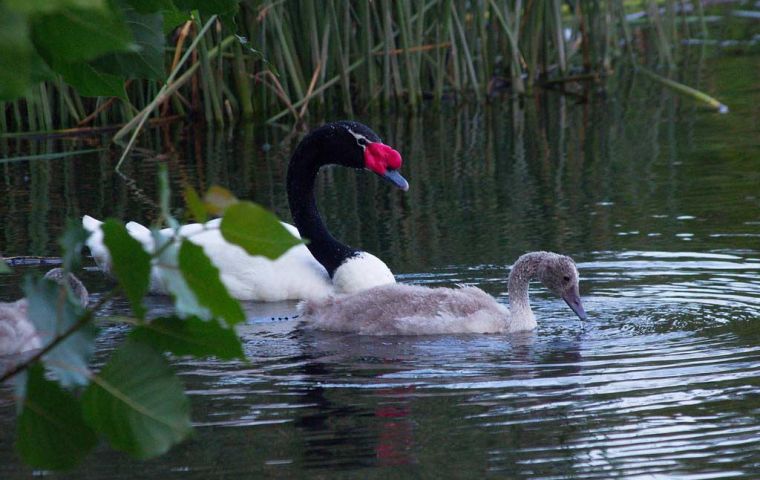MercoPress. South Atlantic News Agency
One detection prompts declaration of avian flu emergency in Uruguay
 Favaro said there were no cases in Brazil but his office admitted this was the largest epidemic of highly pathogenic avian influenza in the world
Favaro said there were no cases in Brazil but his office admitted this was the largest epidemic of highly pathogenic avian influenza in the world Uruguay declared a sanitary emergency nationwide Wednesday following the detection of bird flu in a black-necked swan in the department (province) of Maldonado, some 180 kilometers from the border with Brazil.
“The finding of the H5 highly pathogenic avian influenza virus in a wild species in the area of Laguna Garzón, departments of Maldonado and Rocha,” Livestock Services technician Virginia Russi said during a press conference. “It is very important to isolate wild birds from domestic birds, especially the source of food and water,” she added. “This virus is transmitted by fecal matter, [and] nasal secretions because it has a respiratory, digestive component and nervous symptomatology,” she also pointed out.
According to the World Health Organization, avian influenza, also known as bird flu, is an infectious disease that mainly affects birds and is caused by a virus of the Orthomyxoviridae family. Depending on its subtype, it can be classified as low pathogenic or highly pathogenic, presenting different symptoms in infected birds. The low pathogenic avian influenza virus can cause a mild disease, which may go unnoticed or without the presence of symptoms. Highly pathogenic avian influenza virus, mainly by subtypes (H5 and H7) of type A, causes severe disease in birds that can spread rapidly, producing high mortality rates in different bird species.
Most of the influenza viruses circulating in birds are not zoonotic. However, some strains of highly pathogenic avian influenza can infect humans, posing a threat to public health.
The most common way for the virus to enter a territory is through migratory wild birds. The main risk factor for transmission from birds to humans is direct or indirect contact with infected animals or with environments and surfaces contaminated by feces. Plucking, handling infected poultry carcasses, and preparing poultry for consumption, especially in domestic settings, may also be risk factors.
When avian influenza is transmitted to humans, symptoms in people can range from mild upper respiratory tract infection (fever and cough) to severe pneumonia, acute respiratory distress syndrome (difficulty breathing), shock, and even death.
Experts also said bird flu cannot be transmitted from animals to people through consumption. The malady is highly lethal for birds and affects the respiratory, nervous, and digestive systems, it was explained. In this scenario, tourist visits to poultry farms are highly discouraged. The virus reached South America through “recurrent outbreaks” in the United States and Canada that subsequently spread. In some countries such as Bolivia, Peru, and Ecuador, cases have been registered in commercial farms. In other countries, cases were found among wild birds.
Meanwhile, Brazil's Minister of Agriculture and Livestock Carlos Favaro said on Wednesday that so far there were no cases of avian influenza in commercial or wild animals in the country, Agencia Brasil reported after detections were confirmed in Argentina and Uruguay.
“First, it is important to say that we do not have any case of H1N5 present in Brazil. Therefore, our avian influenza-free status continues,” Favaro told reporters.
“The important thing is that we are going to take measures, which is to strengthen active surveillance, which is to strengthen our inspection, by the Ministry of Agriculture,” he added. He also ruled out paralyzing cargo through the borders but announced stronger surveillance and inspections instead.
There had been three suspected cases, two in Rio Grande do Sul and one in Amazonas, but they were all ruled out after laboratory tests. The minister asked for society's support to identify suspected cases and avoid an outbreak of the disease in Brazil.
“What we have been asking for, the collaboration of everyone, of the press, of society in general, is passive surveillance. Every citizen and every housewife who notices symptoms in a house bird or wild bird, any symptoms of sick birds, inform us immediately so that we can take action and quickly contain these small outbreaks that can happen,” the minister explained.
Brazil is the world's largest exporter of chicken meat. The detection of the disease in wild birds does not cause a commercial impact, but when it occurs in exporting farms, plants may be prevented from selling.
Other measures that might be taken include the culling of infected animals, Agencia Brasil also noted while underlining that, according to Brazilian authorities, this is the largest epidemic of highly pathogenic avian influenza in the world. South America's largest country also insisted that the risk of transmission to people through well-cooked food was considered minimal.




Top Comments
Disclaimer & comment rulesCommenting for this story is now closed.
If you have a Facebook account, become a fan and comment on our Facebook Page!